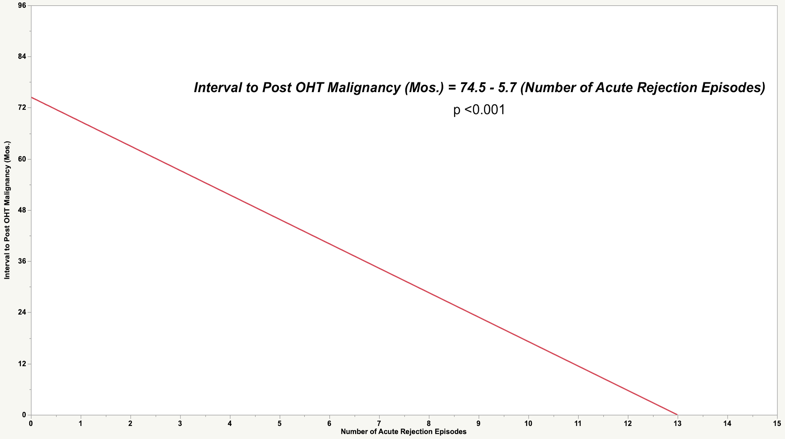The Impact of Acute Rejection in Heart Transplantation on Post-Transplant Malignancy
1Dept. of Surgery, Newark Beth Israel Medical Center, Newark, NJ, 2Dept. of Medicine, Newark Beth Israel Medical Center, Newark, NJ
Meeting: 2019 American Transplant Congress
Abstract number: D328
Keywords: Heart/lung transplantation, Immunosuppression, Malignancy, Rejection
Session Information
Session Name: Poster Session D: PTLD/Malignancies: All Topics
Session Type: Poster Session
Date: Tuesday, June 4, 2019
Session Time: 6:00pm-7:00pm
 Presentation Time: 6:00pm-7:00pm
Presentation Time: 6:00pm-7:00pm
Location: Hall C & D
*Purpose: Compared with the general population, an increased incidence of skin cancers and lymphomas have been shown in orthotopic heart transplant (OHT) recipients. However, the incidence of post OHT malignancies with correlation to the number of rejection episodes has not been investigated. The aim of this study is to describe our single institution experience of post OHT malignancy and its association with acute rejection episodes.
*Methods: A prospectively maintained database of all patients who had an OHT at a single center between 2005-2017 was queried. Malignancies were identified by pathologic reports. The interval to cancer was calculated from the difference in date of diagnosis of malignancy from the transplant date. The database was also queried for the number of rejection episodes. Linear regression models were used to determine the correlation between the number of rejection episodes and time to development of post OHT malignancy.
*Results: Between 2005 and 2017, a total of 603 OHTs were performed at our institution. Of these, the incidence of post OHT malignancy was 7.3%. The two most frequent malignancies were squamous cell carcinoma and post-transplant lymphoproliferative disorder, making up 26% of the post OHT malignancies. The average age of those with a post-transplant malignancy was 57.2 years at time of transplant with 37 (84.2%) of the patients being male. The average interval to cancer after transplant was 56 months, median 48.1 months. Of the 44 post OHT malignancies, 20 (45%) patients had no acute rejection, while 6 (14%) had 1 acute rejection episode, and 18 (41%) patients had two or more rejection episodes. A negative correlation between the number of rejections episodes and the time interval to development of post OHT malignancy was observed (p <0.001), Fig. 1.
Figure 1. Correlation between the number of acute rejection and the time interval in months to the development of post OHT malignancy.
*Conclusions: In our institution, an incidence of 7.3% post OHT malignancies was observed. Consistent with prior studies, the most frequent post OHT malignancies are skin cancers and lymphomas. There is a correlation between the number of acute rejection episodes and the time interval to developing a post OHT malignancy. Close monitoring for post OHT malignancy is warranted among those OHT patients who develop acute rejection.
To cite this abstract in AMA style:
Kamrani K, Okoh A, Hanos D, Camacho M, Zucker M, Clarke K. The Impact of Acute Rejection in Heart Transplantation on Post-Transplant Malignancy [abstract]. Am J Transplant. 2019; 19 (suppl 3). https://atcmeetingabstracts.com/abstract/the-impact-of-acute-rejection-in-heart-transplantation-on-post-transplant-malignancy/. Accessed December 6, 2025.« Back to 2019 American Transplant Congress

